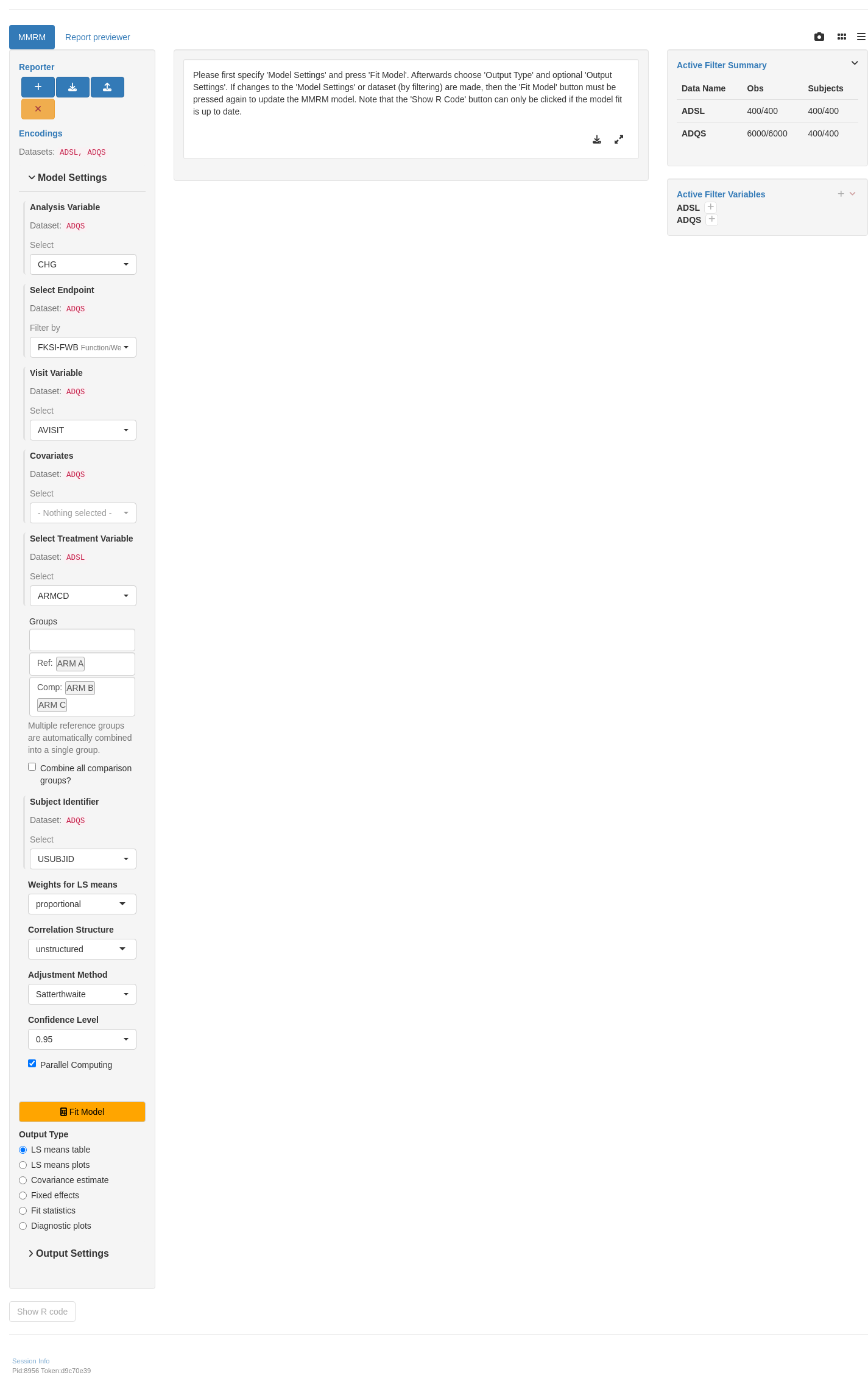---
title: MMRMT01
subtitle: Tables for Mixed-Effect Model Repeated Measures Analysis
---
------------------------------------------------------------------------
{{< include ../../_utils/envir_hook.qmd >}}
```{r setup, echo = FALSE, warning = FALSE, message = FALSE}
library(dplyr)
library(tern.mmrm)
library(broom)
adsl <- random.cdisc.data::cadsl
adqs <- random.cdisc.data::cadqs
# Ensure character variables are converted to factors and empty strings and NAs are explicit missing levels.
adsl <- df_explicit_na(adsl)
adqs <- df_explicit_na(adqs)
adqs_f <- adqs %>%
dplyr::filter(PARAMCD == "FKSI-FWB" & !AVISIT %in% c("BASELINE", "SCREENING")) %>%
droplevels() %>%
dplyr::mutate(ARMCD = factor(ARMCD, levels = c("ARM B", "ARM A", "ARM C"))) %>%
dplyr::mutate(
AVISITN = rank(AVISITN) %>%
as.factor() %>%
as.numeric() %>%
as.factor()
)
adsl_sub <- adqs_f %>%
dplyr::filter(!is.na(CHG)) %>%
distinct(USUBJID) %>%
left_join(adsl, by = "USUBJID")
var_labels(adqs_f) <- var_labels(adqs)
```
::: panel-tabset
## Least Squares Means
#### Considering the treatment variable in the model
```{r variant1, test = list(result_v1 = "result"), message = FALSE}
mmrm_results <- fit_mmrm(
vars = list(
response = "CHG",
covariates = c("BASE", "STRATA1", "BMRKR2"),
id = "USUBJID",
arm = "ARMCD",
visit = "AVISIT"
),
data = adqs_f,
weights_emmeans = "equal"
)
df <- tidy(mmrm_results)
attr(df$AVISIT, "label") <- "Visit"
# Define the split function
split_fun <- drop_split_levels
result <- basic_table(show_colcounts = TRUE) %>%
split_cols_by("ARMCD", ref_group = mmrm_results$ref_level) %>%
split_rows_by("AVISIT", split_fun = split_fun, label_pos = "topleft", split_label = obj_label(df$AVISIT)) %>%
summarize_lsmeans(show_relative = "increase") %>%
append_topleft(" Statistics") %>%
build_table(df, alt_counts_df = adsl_sub)
result
```
#### Not considering the treatment variable in the model
```{r variant2, test = list(result_v2 = "result")}
mmrm_results_no_arm <- fit_mmrm(
vars = list(
response = "CHG",
covariates = c("BMRKR2", "STRATA1"),
id = "USUBJID",
visit = "AVISIT"
),
data = adqs_f,
weights_emmeans = "equal",
parallel = TRUE
)
df_no_arm <- tidy(mmrm_results_no_arm)
attr(df_no_arm$AVISIT, "label") <- "Visit"
# Define the split function
split_fun <- drop_split_levels
result <- basic_table(show_colcounts = TRUE) %>%
add_overall_col("All Patients") %>%
split_rows_by("AVISIT", split_fun = split_fun, label_pos = "topleft", split_label = obj_label(df_no_arm$AVISIT)) %>%
summarize_lsmeans(arms = FALSE) %>%
append_topleft(" Statistics") %>%
build_table(df_no_arm, alt_counts_df = adsl_sub)
result
```
#### Adding baseline rows
It may be of interest to summarize some different statistics at the baseline visit or summarize a different variable in the data set not used in the MMRM. For example, the model may use the variable `CHG` but the baseline visit row may summarize the `AVAL` variable, thus we would need to create two tables and then combine them to accomplish this.
```{r variant_baseline, test = list(result_baseline = "result")}
# First have the least-square means table.
a <- basic_table(show_colcounts = TRUE) %>%
split_cols_by("ARMCD", ref_group = mmrm_results$ref_level) %>%
split_rows_by("AVISIT", split_fun = split_fun, label_pos = "topleft", split_label = obj_label(df$AVISIT)) %>%
summarize_lsmeans(show_relative = "increase") %>%
append_topleft(" Statistics") %>%
build_table(df, alt_counts_df = adsl_sub)
# Second prepare the baseline values summary table.
baseline_dat <- adqs %>%
filter(AVISIT == "BASELINE") %>%
distinct(USUBJID, .keep_all = TRUE) %>%
droplevels()
b <- basic_table(show_colcounts = TRUE) %>%
split_cols_by("ARMCD") %>%
split_rows_by("AVISIT") %>%
analyze_vars("AVAL") %>%
append_topleft(" Statistics") %>%
build_table(baseline_dat, alt_counts_df = adsl_sub)
# Now we can combine them as follows.
col_info(b) <- EmptyColInfo
rbind(b, a)
```
#### Considering visit averages
It may also be of interest to summarize several different statistics for an averaged combination of various visits in the MMRM. For example, you may want to see the statistics for the average of the first 2 visits, or the average statistics of all visits combined. This can be accomplished by specifying the `averages_emmeans` argument when fitting the MMRM model.
```{r variant3, test = list(result_v3 = "result")}
mmrm_results_avg_visits <- fit_mmrm(
vars = list(
response = "CHG",
covariates = c("BASE", "STRATA1", "BMRKR2"),
id = "USUBJID",
arm = "ARMCD",
visit = "AVISIT"
),
data = adqs_f,
weights_emmeans = "equal",
averages_emmeans = list(
"WEEKS 1-2" = c("WEEK 1 DAY 8", "WEEK 2 DAY 15"),
"WEEKS 3-5" = c("WEEK 3 DAY 22", "WEEK 4 DAY 29", "WEEK 5 DAY 36"),
"ALL VISITS" = c("WEEK 1 DAY 8", "WEEK 2 DAY 15", "WEEK 3 DAY 22", "WEEK 4 DAY 29", "WEEK 5 DAY 36")
)
)
df_avgs <- tidy(mmrm_results_avg_visits)
attr(df_avgs$AVISIT, "label") <- "Visit"
# Define the split function
split_fun <- drop_split_levels
result <- basic_table(show_colcounts = TRUE) %>%
split_cols_by("ARMCD", ref_group = mmrm_results_avg_visits$ref_level) %>%
split_rows_by("AVISIT", split_fun = split_fun, label_pos = "topleft", split_label = obj_label(df_avgs$AVISIT)) %>%
summarize_lsmeans(show_relative = "increase") %>%
append_topleft(" Statistics") %>%
build_table(df_avgs, alt_counts_df = adsl_sub)
result
```
## Fixed Effects
#### Considering the treatment variable in the model
```{r}
as.rtable(mmrm_results, type = "fixed")
```
#### Not considering the treatment variable in the model
```{r}
as.rtable(mmrm_results_no_arm, type = "fixed")
```
## Covariance Matrix
```{r}
as.rtable(mmrm_results, type = "cov")
```
## Model Diagnostics
Model diagnostics are currently available to evaluate choice of covariates for the fixed and random effects. Statistics to evaluate choice of covariance structure are being investigated and will be included in a future release.
```{r}
as.rtable(mmrm_results, type = "diagnostic")
```
## Data Setup
```{r setup}
#| code-fold: show
```
:::
{{< include ../../_utils/save_results.qmd >}}
## `teal` App
```{r teal, opts.label = c("skip_if_testing", "app")}
library(teal.modules.clinical)
## Data reproducible code
data <- teal_data()
data <- within(data, {
library(dplyr)
ADSL <- random.cdisc.data::cadsl
ADQS <- random.cdisc.data::cadqs %>%
filter(ABLFL != "Y" & ABLFL2 != "Y") %>%
filter(AVISIT %in% c("WEEK 1 DAY 8", "WEEK 2 DAY 15", "WEEK 3 DAY 22")) %>%
mutate(
AVISIT = as.factor(AVISIT),
AVISITN = rank(AVISITN) %>%
as.factor() %>%
as.numeric() %>%
as.factor() # making consecutive numeric factor
)
})
join_keys(data) <- default_cdisc_join_keys[c("ADSL", "ADQS")]
## Reusable Configuration For Modules
ADQS <- data[["ADQS"]]
arm_ref_comp <- list(
ARMCD = list(
ref = "ARM A",
comp = c("ARM B", "ARM C")
)
)
## Setup App
app <- init(
data = data,
modules = modules(
tm_a_mmrm(
label = "MMRM",
dataname = "ADQS",
aval_var = choices_selected(c("AVAL", "CHG"), "CHG"),
id_var = choices_selected(c("USUBJID", "SUBJID"), "USUBJID"),
arm_var = choices_selected(c("ARM", "ARMCD"), "ARMCD"),
visit_var = choices_selected(c("AVISIT", "AVISITN"), "AVISIT"),
arm_ref_comp = arm_ref_comp,
paramcd = choices_selected(
choices = value_choices(ADQS, "PARAMCD", "PARAM"),
selected = "FKSI-FWB"
),
cov_var = choices_selected(c("BASE", "AGE", "SEX", "BASE:AVISIT"), NULL),
conf_level = choices_selected(c(0.95, 0.9, 0.8), 0.95)
)
)
)
shinyApp(app$ui, app$server)
```
{{< include ../../repro.qmd >}}

